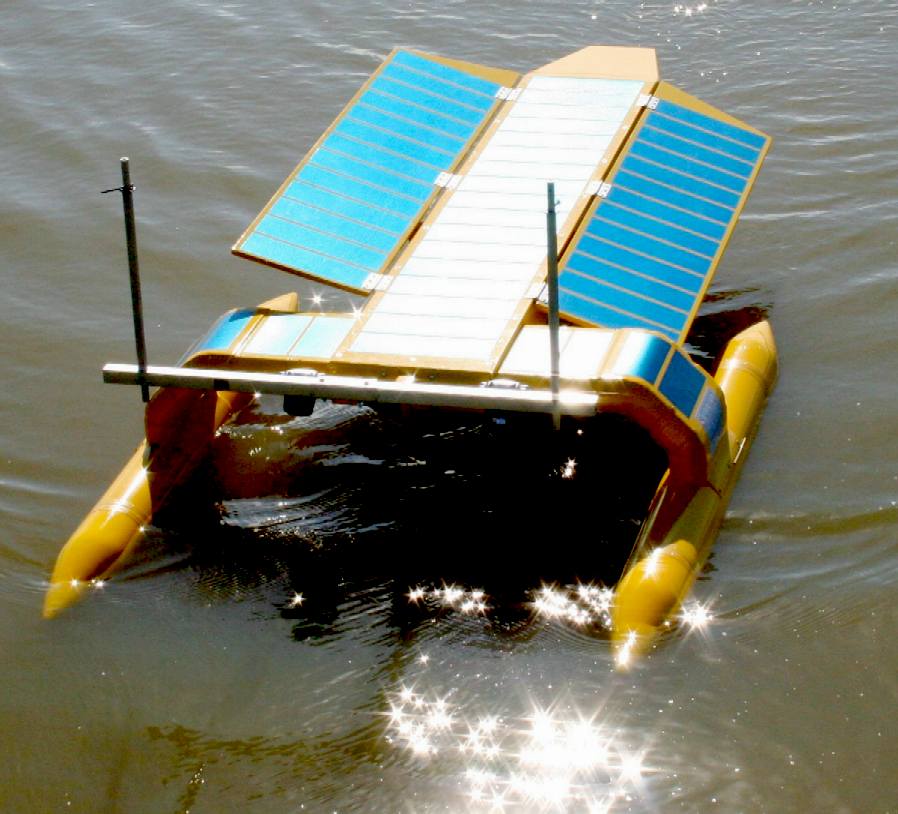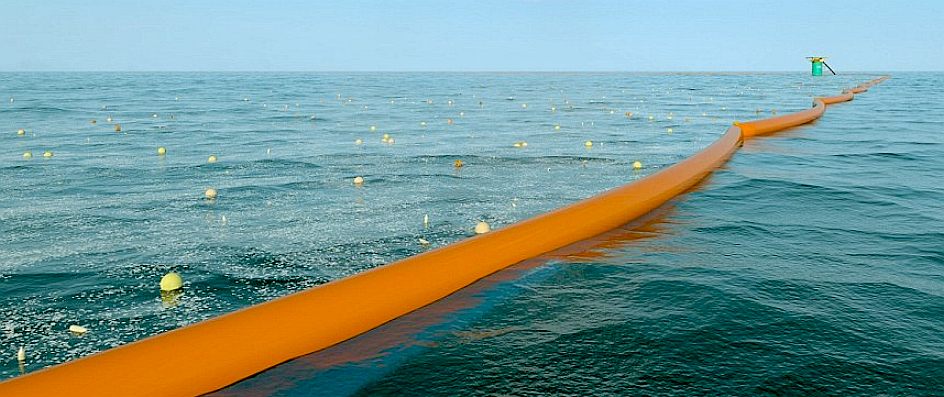|
IHS
ENGINEERING 360 2 FEBRUARY 2016

RIVERVAX™
- Is a potential solution for surface (and subsurface) river
and ocean pollution that is cost effective.
The value of such a versatile vessel might not be limited to the ability
to vacuum the Ganges
clean for example, but the blue water version, called SeaVax,
could target any area of the high seas that is rich enough in
plastic waste to make it worthwhile for the operators. This go
anywhere workboat is solar and wind
powered, another step forward for any nation that is doing their
level best to combat climate
change and acid oceans. The
vessel is designed to hold 150 tons of waste until it can
discharge at sea to a transfer tanker, or dock in port and
discharge directly to waiting treatment plants.
ROBOTIC
VESSEL COULD CLEAN TRASH FROM OCEANS
Sail into the middle of any of the world's oceans and you will not necessarily find clear blue water. Instead you may well encounter a “gyre” or concentration of floating plastic refuse. Indeed, anywhere from 8-12 million tonnes of the material is currently estimated to be out there with potentially serious environmental consequences, including degradation of the foodchain if it is ingested by marine life. The financial damage this causes has been estimated by the United Nations to be the equivalent of $13
billion
per year.
A small UK company has come up with a possible solution – the design for a highly innovative and completely autonomous type of vessel that could patrol the seas for lengthy periods of time collecting the waste material like a gigantic “seaborne vacuum cleaner.” The description is provided by Chris Close, project leader with Bluebird Marine Systems, based at
Herstmonceux, Sussex, close to the
English Channel
Coast, in an initiative which aims to develop a highly innovative vessel aptly called the SeaVax.
The SeaVax will be a 140-foot-long trimaran
capable of propelling itself almost endlessly by means of electric motors powered by a mix of on-board wind turbines and an array of solar panels that cover most of its upper surface. More pertinently, the other key capability of the vessel is that it can be guided by remote command toward known gyres of plastic, detect their precise location and then collect and store up to 150 tons of the material for retrieval either after it has returned to shore or even while still at sea.
Appropriately for a vessel intended to help improve the global environment, the SeaVax will also aim to set a new standard for the efficiency with which electrical propulsion can be used on water. Until now, says Close, no solar powered vessel has exceeded a power-to-weight ratio of 0.98kW per ton. The SeaVax is intended to multiply that performance level several times. A 30-ton version of the vessel will achieve a ratio of 2.2kW per ton, and a 50-ton version will achieve 1.32kW per ton. But theoretically, he says, a high-performance rather than workboat vessel like the SeaVax could push those figures as high as 5-7kW per ton. It will do so by combining its mix of on-board power generation capability with a number of other techniques that will optimize efficiency.
One of these is that the wind turbines will be mounted on telescopic booms. This will enable them to be either retracted close to the hull to avoid damage in storm conditions or to be raised so that their tips rise 23 meters above the water to catch the stronger windflows at that height. This capability will be combined with a “solar tracking” system driven by on-board computer
hardware, which means that the turbines and solar panels will never operate in ways that compromise overall power generation potential.
Close says that not only will the solar panels be able to rotate to keep them pointing directly at the sun, but the software will also ensure that the turbines will not be deployed in a way that would cause them to cast a shadow over the panels. He describes the overall concept as that of an “active hull” and says that the use of the two power generation technologies in such a context is unprecedented. “There has never been a vessel that has had active solar tracking and active wind turbines operating together,” he says.
In detail, the relevant figures are that the vessel should be capable of generating a total of 84kW of power – 40kW from its two turbines and 44kW from its 220m2 of solar panels.
Another task for the on-board computing resource will be to ensure that the vessel is fully compliant with relevant collision avoidance regulations. In order to achieve this, the vessel will use sensor technologies including laser-based LIDAR. The total amount of computing power required to control all the vessel's operations will, Close says, be roughly equal to a couple of high-end PCs.
At the moment, the SeaVax
concept exists only as a one-twentieth scale model, but the company is looking for the finance that would enable it to build the first of what it envisages as a flotilla of the vessels at full scale. Close says that around £2.5 million ($3.75 million) is needed to get a basic aluminium-hulled vessel into the water that would demonstrate its seaworthiness. As much as three times that amount would be required to create a vessel equipped with the necessary control software and equipment for retrieving and handling the waste materials.
At present, some details of precisely how the vessel will operate remain confidential because any premature disclosure would prejudice the company's ability to
patent
them. These include how it will zero in on concentrations of waste and a projected methodology for offloading the material to a larger transport vessel while at sea. But the company says that the vessel will use a “multi-filtration” technique that will enable it first to identify and then deal with the sheer variety of material it may encounter, which could range upwards from microplastic particles to abandoned fishing nets weighing as much as 10
tonnes. By Mike Farish
More information: www.bluebird-electric.net
OCEAN
CLEANUP PROJECT
SeaVax
is relatively fresh to the scene, but Dutch inventor Boyan
Slat, 21, has been working on setting giant floating traps for
fishermen and other commercial shipping since 2014. His not
for profit organisation is planning to float large booms
across targeted sections of the ocean, that are anchored
to the ocean floor.
His
team of almost 100 experts claim that plastic waste will be
concentrated by the booms set in a 'V' formation, as the ocean
currents drift by. The concentrated plastic soup will then be
collected by a ship about once a month.

OPEN
WATER HAZARD - Boyan Slat's company estimates that a 62-mile stationary cleanup array could remove 42 per cent of the Great Pacific Garbage Patch over 10 years, representing a total of 70,320,000kg of plastic waste.
We would not want to be the Captain of a small boat encountering
this obstacle at night. Are the towers to be lit up like
miniature lighthouses? Surely, ships will need to be able to see where
these booms are located. Undeniably they present a potential
danger to marine traffic, unless good warning is given both
visually and digitally on maps - perhaps also with some kind
of audible warning system - though it might be too late by
then. You can just imagine the
entanglements that could arise, physical and legal. Could
though, tankers and cargo ships simply steam over the flexible
barrier without damaging it or themselves- the propellers
being the only real danger. It is 50/50 whether the bulbous
nose of most large ships will go over or under the booms. If
the nose goes over, great. In the nose goes under - disaster
for the boom anchoring.

LINKS
& REFERENCE
https://ecowatch.com/2016/02/19/seavax-vacuum-ocean-plastic/
http://theterramarproject.org/thedailycatch/prototype-for-robotic-boat-suck-plastic-waste-unveiled-innovate-uk/
5gyres
blog posts 2016
gyres_in_india_contrasts_of_rich_and_poor_where_does_the_plastic_pollution_go
http://www.globalspec.com/
Outside
Online ocean doubt
DailyMail
UK news 20 year old inventors plan clean ocean five years
practise Japan year
http://www.dailymail.co.uk/home/search.html?s=&authornamef=Becky+Pemberton+For+Mailonline
http://www.dailymail.co.uk/home/search.html?s=&authornamef=Fiona+Macrae+for+the+Daily+Mail
http://www.dailymail.co.uk/travel/travel_news/article-3112298/20-year-old-inventor-s-plan-clean-ocean-five-years-practise-Japan-year.html
http://www.outsideonline.com/1999216/ocean-doubt
https://www.youtube.com/user/TheOceanCleanup
https://scripps.ucsd.edu/
www.bluebird-electric.net
http://www.oceanconservancy.org/
http://www.theoceancleanup.com/
http://insights.globalspec.com/article/2132/cleanup-systems-aim-to-stem-the-tide-of-ocean-plastic-pollution
http://www.globalspec.com/
http://www.5gyres.org/blog/posts/2014/04/17/5_gyres_in_india_contrasts_of_rich_and_poor_where_does_the_plastic_pollution_go
http://www.bluebird-electric.net/oceanography/Ocean_Plastic_International_Rescue/SeaVax_Ocean_Clean_Up_Robot_Drone_Ship_Sea_Vacuum.htm
http://theterramarproject.org/thedailycatch/prototype-for-robotic-boat-suck-plastic-waste-unveiled-innovate-uk/
https://ecowatch.com/2016/02/19/seavax-vacuum-ocean-plastic/
http://www.energymatters.com.au/renewable-news/solar-wind-seavax-em5350/
http://www.csiro.au/en/News/News-releases/2015/Marine-debris
http://www.express.co.uk/search/Maisha+Frost%252C+Exclusive?s=Maisha+Frost%2C+Exclusive&b=1
http://www.express.co.uk/finance/city/638166/New-cleaner-SeaVax-has-solution-to-ocean-plastic-waste
|